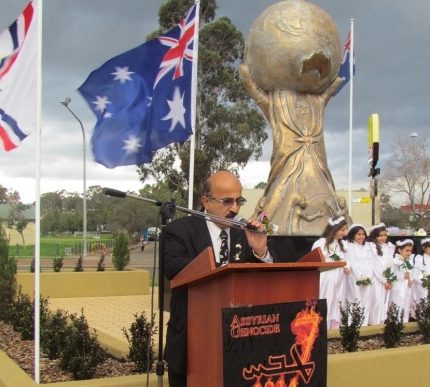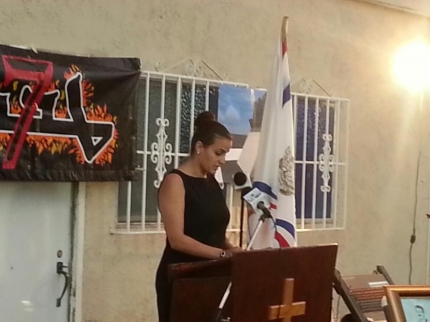Historical records of the 19th and the beginning of the 20th century indicate that Gawar included 23 to 30 villages; the number is variable because kurds and Turks used to destroy the villages and Assyrians re-built them. Inhabitants lived from agriculture, mainly of wheat and barley, cotton, tea and all these villages were purely Assyrian with a few numbers of Jews among them. According to Dr Edward Cutts, Gawar included 1497 families in the 1880s (2).
Till the World War I, Gawar was the seat of a bishop of the Church of the East where the hereditary position was held by the family of Mar Sliwa clan, originally from Mar Zayya village of Jilu district, while both clans of Mar Zayya and Mar Sargis of jilu belong to same origin, Beth Abbouna D’Jilu (Jilu’s Bishops Family), and his parish included beside Gawar, the regions of Deranayeh, Noodes, Tchal, Khananis and Albeq, all together about 80 villages .
Like other Assyrians, the Mar Sliwa family suffered the Kurdish and Turkish persecution through centuries, but being in the plains and not in highlands, Gawar, Albeq and Salamas villages suffered more than other districts because its inhabitants were subjects of the Ottoman-Islamic occupation, unlike their brethren of the highlands (the independent tribes of Tyari, Jilu, Baz, Diz, Tkhuma).
After the massacres committed by the kurdish chief Baderkhan and the Kurdish tribes in 1840s, a visitor to the Assyrians, Justin Perkins (1805-1869) who was an American missioner, met Mar Sliwa the bishop of Gawar, that was in March//03/1843 describing him as follows: “Mar Sleeva is too poor to cloth himself decently, he and his people having not long since been overrun and plundered by the savage koords, He therefore left deeply his loss, as well as the indignity of the outrage. I requested one of our priests who was present to give to the poor sufferer a cheap shawl from his own cap, promising to procure another for the priest. The venerable, simple-hearted man was deeply affected with the kindness, and implored many blessings on me in return” (3)
According to Perkins, in that meeting Mar Sliwa said that only about 100 family are still in Gawar after the Kurdish massacre of Bederkhan, and Perkins is describing the situation of Gawar and other Assyrian districts as follows: “The koords treat the Nestorians, who are subjects to their spoliation, as they do their bees, – leave them quiet till the hive is worth taking up and then rob it” (4)
The heredity of the bishop family stopped during the WW1, when all the family members were beheaded by the kurds in Gegoran village in 1914, only one was left, namely Younathan Giwargis who was Mar Sliwa’s nephew, a young man aged 25 years at that time, studying theology and Assyrian language in the patriarchate in Qudshanis, under the supervision of the patriarchal family and Dr. William Wigram in preparation to be the new Bishop of Gawar.
Even Younathan Giwargis couldn’t be later a bishop because he participated to the Assyrian attack on Koynashahir city, revenging the killing of the Assyrian patriarch Mar Binyamin Shimmun in 1918, who was killed by the Kurdish chief “Ismaeil Simko” in the city.
In 1924 Younathan married an Assyrian girl from Ardishaiir (Assyrian village in Salamas District) and had only one son who was again prepared by the Mar Shimmun family to be the new bishop of Gawar, but the massacres committed by the Iraqi against the Assyrians in Aug/1933 prevented Younathan’s son, namely Giwargis, to continue his studies under the supervision of Lady Surma (Mar Binyamin Sister), because the patriarchal family was exiled by the British mandate to Cyprus in 1933, and Giwargis and his father were exiled to Syria with 12.000 Assyrians.
Prior to the final demarcation of the Turko-Iranian border, the district of Gawar served as the main travel stop for Assyrians traveling between the Hakkari tribal areas and the Urmia plains. At various times in the 19th century the residents of many Assyrian villagers from the district were forced to convert to Islam or were killed.
The Assyrian population in Gawar suffered from two major events during WW1. In October 1914, Gawar, Albaq and Salamas were the first districts targeted under the motto of "Jihad", where thousands were slaughtered and hundreds of villages were completely burned and destroyed.
Today the grandsons of Gawar inhabitants are distributed around the world just like other Assyrians, and the district is fully inhabited by kurds, just like all Assyrian highlands and plains of south-east of what is called today: “Turkey”.
By Ashur Giwargis
Beirut, Oct/06/2012
* Ashur Giwargis, a grandson of Younathan Giwargis, Beirut
(1) G. Maspero : :"Hitory Of Egypt, Chaldaea, Syria, Babylonia, and Assyria",V8, special study by Project Gutenberg
(2) E.L.Cutts : “Christians under the crescent in Asia”, London, P: 355
(3) Rev. Justin Perkins : “A residence of eight years in Persia among the Nestorian Christians”, New York, 1843 – P: 304.
(4) Perkins, P: 316.




